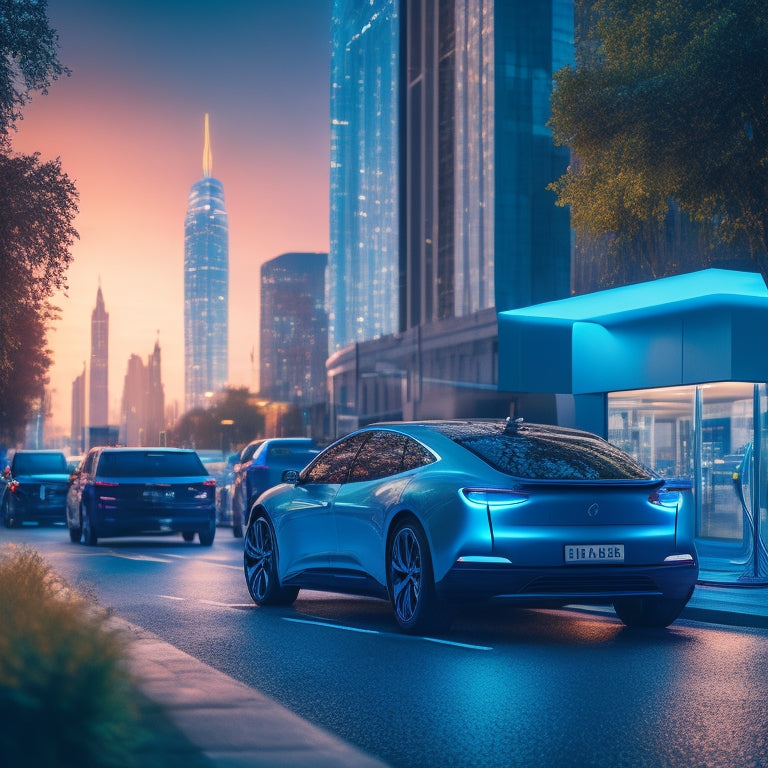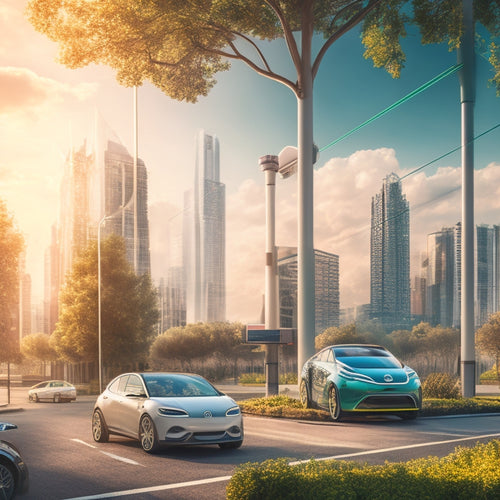
Urban EV Charging Infrastructure for Sustainable Cities
Share
You're spearheading the effort to create sustainable cities by investing in urban EV charging infrastructure. Strategically placing charging stations in high-traffic areas, like corner spots and intersections, is essential. Fast charging technology, capable of replenishing EV batteries to 80% in under 30 minutes, is vital for reducing range anxiety. Smart charging systems optimize energy distribution, utilizing time-of-use pricing and load balancing to prevent grid strain. As you explore the world of urban EV charging infrastructure, you'll discover the many facets of sustainable city planning, from overcoming range anxiety to optimizing urban design. The possibilities are endless, and the future of sustainable transportation is just ahead.
Key Takeaways
• Optimal charging station locations are crucial, considering urban landscape, high-traffic areas, and zoning regulations for efficient infrastructure.
• Public charging networks offer economic incentives, reduced range anxiety, and environmental benefits, increasing convenience for EV owners.
• Fast charging technology advancements enable 80% recharge in under 30 minutes, significantly reducing range anxiety and increasing adoption.
• Smart charging systems prioritize efficient energy distribution, load balancing, and excess energy storage to prevent grid strain and manage demand proactively.
• Urban planning strategies integrate EV-friendly design principles, prioritizing green spaces, accessibility, and convenience to create sustainable cities.
Urban EV Charging Station Locations
Analyzing the urban landscape is crucial in identifying optimal locations for urban EV charging stations. By carefully considering factors such as high-demand areas, traffic patterns, and existing infrastructure, you can ensure convenient and effective charging experiences for users.
Identifying key urban hubs, like shopping centers, public transportation terminals, and entertainment districts, where people naturally gather, is paramount. These locations typically have high foot traffic, making them perfect spots for EV charging stations.
Furthermore, take into account corner spots at intersections, as they offer easy accessibility and visibility for drivers. Placing charging stations strategically in these areas can help alleviate range anxiety and promote EV adoption.
Evaluating population density, traffic volume, and local zoning regulations is also crucial in optimizing the placement of charging stations. This data-driven approach will result in a well-organized and efficient urban EV charging infrastructure, ultimately contributing to a more sustainable city.
Benefits of Public Charging Networks
By accessing public charging networks, you can gain a multitude of benefits that enhance the overall EV driving experience, from reduced range anxiety to increased charging convenience. As an EV owner, you'll appreciate the peace of mind that comes with knowing you can charge your vehicle on the go.
Here are just a few advantages of public charging networks:
-
Economic Incentives: Many cities offer discounted rates for public charging, making it a cost-effective option for EV owners.
-
Reduced Range Anxiety: With a robust public charging network, you can drive further without worrying about running out of juice.
-
Environmental Impact: By switching to electric vehicles and utilizing public charging networks, you're reducing greenhouse gas emissions and contributing to a cleaner environment.
Fast Charging Technology Advancements
You're now benefiting from fast charging technology that can replenish your EV's battery to 80% in under 30 minutes, thanks to advancements in high-power charging. This rapid replenishment is made possible by the development of high-power charging (HPC) systems, which can deliver up to 350 kW of power.
To put this into perspective, that's a significant jump from the 50 kW charging speeds of just a few years ago. The key to achieving such high power levels lies in advanced cooling systems, which enable the efficient dissipation of heat generated during charging. This, in turn, allows for the safe and reliable transfer of electricity to your vehicle.
With fast charging technology, you can now drive long distances without worrying about running out of juice. As charging speeds continue to increase, the range anxiety that once plagued EV owners will become a thing of the past.
Smart Charging Systems for Cities
As you design smart charging systems for cities, you'll need to prioritize efficient energy distribution, ensuring that power is allocated effectively across the network.
This requires optimizing charging networks to manage energy demand and reduce strain on the grid.
Efficient Energy Distribution
Cities can substantially reduce strain on the grid by implementing smart charging systems that optimize energy distribution, ensuring that electric vehicles are charged during off-peak hours when energy demand is low. This approach not only reduces peak demand but also increases grid resiliency. As you integrate electric vehicles into your urban infrastructure, you'll want to ponder how to efficiently distribute energy.
Here are a few ways smart charging systems can optimize energy distribution:
-
Time-of-Use (TOU) pricing: Charging rates are adjusted based on the time of day, encouraging drivers to charge during off-peak hours.
-
Load balancing: The system distributes energy across multiple charging stations, preventing overloading and reducing strain on the grid.
-
Energy harvesting: Excess energy generated from renewable sources can be stored and used to charge vehicles during peak hours.
Optimized Charging Networks
Implementing optimized charging networks enables cities to manage EV charging demand proactively, ensuring a seamless and efficient charging experience while minimizing the strain on the electrical grid.
As you plan and deploy EV charging infrastructure, it's essential to prioritize network optimization to avoid network congestion. By distributing charging loads across multiple charging hubs, cities can reduce peak demand and alleviate pressure on the grid.
This smart approach allows you to balance charging demand with available energy supply, ensuring a reliable and efficient charging experience for EV owners. By integrating advanced data analytics and IoT sensors, you can monitor and adjust charging patterns in real-time, further optimizing network performance.
Real-Time Monitoring Systems
By leveraging real-time monitoring systems, you can dynamically track and adjust EV charging patterns, guaranteeing that your city's charging infrastructure operates at peak levels. This enables you to identify areas of inefficiency and optimize your network in real-time.
With real-time monitoring, you can:
-
Analyze charging patterns: Gain insights into usage patterns, including peak hours, energy consumption, and charging speeds.
-
Detect anomalies: Identify technical issues, such as faulty charging stations or network congestion, and address them promptly.
-
Optimize network performance: Use data analytics to optimize charging station placement, reduce congestion, and ensure a seamless user experience.
Urban Planning for EV Infrastructure
As you design urban spaces, you'll need to prioritize EV-friendly urban design principles that integrate electric vehicle charging infrastructure seamlessly. This involves strategically placing charging stations in high-demand areas, such as near public transportation hubs, shopping centers, and residential areas.
EV-Friendly Urban Design
You'll need to integrate electric vehicle (EV) charging infrastructure into your urban design, ensuring that 20-30% of parking spaces in new developments are EV-ready, an essential step towards creating sustainable cities. This integration won't only support the growing demand for EVs but also contribute to a cleaner environment.
To achieve this, consider the following urban design strategies:
-
Prioritize green spaces: Incorporate green spaces into your urban design to mitigate the urban heat island effect and provide a calming atmosphere for residents. This can include parks, gardens, or even green roofs.
-
Optimize urban density: Strategically plan urban density to reduce the need for lengthy commutes, promoting a more sustainable and efficient use of resources. This can be achieved through mixed-use developments and compact, walkable neighborhoods.
-
Design for accessibility: Make sure that EV charging infrastructure is easily accessible, convenient, and visible, encouraging widespread adoption of EVs.
Charging Station Placement
Identifying high-demand areas, such as shopping centers, public parking garages, and transit hubs, is essential for strategic placement of EV charging stations, ensuring convenient access to charging infrastructure for urban residents and commuters. As you plan the placement of charging stations, consider the urban density and land use patterns of your city.
| Location Type | Charging Station Density |
|---|---|
| High-Density Residential | 1 station per 500 residents |
| Commercial Districts | 1 station per 200 parking spaces |
| Public Parking Garages | 1 station per 50 parking spaces |
| Transit Hubs | 1 station per 10,000 passengers/day |
| Urban Fringe Areas | 1 station per 1,000 residents |
Overcoming Range Anxiety Barriers
By 2025, nearly 40% of urban residents will own an EV, but range anxiety remains a significant barrier to widespread adoption, with 75% of potential buyers citing it as a top concern. As you consider joining the EV revolution, you're likely wondering how you'll overcome this hurdle.
The truth is, range anxiety is largely a psychological barrier, fueled by a lack of understanding and visibility into charging infrastructure. To combat this, you need Range Education. This involves educating potential buyers on the actual range and capabilities of EVs, as well as the vast network of charging stations available.
Additionally, Anxiety Mapping can help alleviate concerns by providing a visual representation of charging infrastructure, making it easy to identify nearby charging points and plan your route accordingly. By providing this information upfront, you'll be more confident in your EV's capabilities, and range anxiety will become a thing of the past.
Some key strategies to overcome range anxiety include:
-
Improving public awareness of charging infrastructure through interactive maps and real-time data
-
Providing EV owners with personalized range and charging plans tailored to their specific needs
-
Offering test drives and trial periods to give potential buyers hands-on experience with EVs
EV Charging Infrastructure Costs
As urban planners and policymakers invest heavily in EV infrastructure, understanding the costs associated with building and maintaining a thorough charging network is vital, with estimates suggesting that the total cost of installing a single public Level 2 charger can range from $3,000 to $10,000.
Breaking down the costs, you'll find that hardware and installation costs account for a significant portion of the total expenditure. Here's a rough estimate of the costs involved:
| Cost Component | Estimated Cost |
| Hardware (charger, cable, etc.) | $1,500 - $3,000 |
| Installation (labor, materials, etc.) | $1,000 - $2,000 |
| Electrical upgrades (if necessary) | $500 - $1,000 |
| Land acquisition/lease (if necessary) | $1,000 - $5,000 |
| Ongoing maintenance and operations | $500 - $1,000/year |
When considering the financial projections for a large-scale EV charging infrastructure, it's important to factor in these costs to ensure accurate cost estimates. By understanding the costs involved, you can make informed decisions about your EV infrastructure investments.
Government Incentives for EV Adoption
You'll likely need to factor in government incentives when calculating the total cost of EV infrastructure development, since these incentives can greatly offset the costs outlined above. Governments around the world are offering various incentives to encourage the adoption of electric vehicles and the development of supporting infrastructure. These incentives can notably reduce the financial burden of EV infrastructure development.
Some of the most common government incentives for EV adoption include:
-
Tax Credits: Many governments offer tax credits to individuals and businesses that invest in EV infrastructure, such as charging stations.
-
Rebate Programs: Governments may offer rebates to individuals and businesses that purchase electric vehicles or install EV charging stations.
-
Grants and Low-Interest Loans: Governments may provide grants or low-interest loans to support the development of EV infrastructure, such as charging corridors along highways.
Urban EV Charging Station Design
When designing an urban EV charging station, you'll need to take into account three key aspects.
First, the station's aesthetics will impact its integration into the urban landscape, so you'll want to choose a design that complements its surroundings.
Station Aesthetics Matter
Designing urban EV charging stations that blend seamlessly into their surroundings is essential, as visually unappealing stations can hinder widespread adoption of electric vehicles. As you envision the urban EV charging infrastructure of the future, you'll want to prioritize station aesthetics that complement the urban landscape.
A well-designed charging station can become an integral part of the city's Architectural Vision, enhancing the Urban Identity of the area.
To achieve this, consider the following key factors:
-
Material harmony: Choose materials that blend with the surrounding architecture, ensuring the station doesn't stand out for the wrong reasons.
-
Minimalist approach: Avoid clutter and focus on clean lines, simplicity, and functionality to create a visually appealing station.
-
Integration with public art: Incorporate public art or interactive installations to create an engaging and welcoming atmosphere.
Efficient Space Planning
Here's the output:
Optimizing urban EV charging station layouts is essential to maximize space efficiency, as compact designs can accommodate more charging points, reduce land use, and enhance the overall user experience. You'll want to prioritize efficient space planning to make the most of your urban EV charging infrastructure.
| Design Element | Space-Efficient Solution |
|---|---|
| Charging Point Layout | Alternate 90-degree parking and charging points to increase capacity |
| Pedestrian Access | Designate pedestrian zones to separate from vehicle traffic |
| Landscaping | Incorporate green walls or roofs to reduce urban heat island effect |
| Wayfinding | Implement clear signage and lighting to guide users through the station |
Accessibility Standards
You'll need to ensure that your urban EV charging station design meets accessibility standards, as users with disabilities must be able to easily navigate and use the facilities. This is important for creating inclusive infrastructure that promotes sustainable cities.
By incorporating Universal Design principles, you can guarantee that your charging station is accessible to everyone, regardless of their abilities.
Here are some key considerations to keep in mind:
-
Clear signage and wayfinding: Make sure that signs are clear, concise, and easily readable, with high contrast colors and Braille or tactile lettering for visually impaired users.
-
Accessible pathways and parking: Design pathways and parking areas that are wide, flat, and obstacle-free, with ample space for wheelchairs and mobility aids.
-
Adaptable charging points: Install charging points at varying heights and with adjustable cables to accommodate users with different mobility needs.
Future of Urban EV Charging Systems
As electric vehicles increasingly dominate urban roads, what role will advanced charging systems play in sustaining the momentum of sustainable cities?
You're likely wondering how urban EV charging infrastructure will evolve to support the growing demand for clean transportation.
The future of urban EV charging systems lies in integrated, grid-resilient solutions that prioritize Vehicle Autonomy.
Imagine a network of smart charging stations that can dynamically adjust their power output based on real-time grid conditions, ensuring Grid Resilience and minimizing strain on the electrical infrastructure.
As you navigate the city, your EV seamlessly communicates with the charging network, optimizing charging times and routes to minimize congestion and reduce emissions.
Advanced charging systems will enable Vehicle Autonomy, allowing your EV to charge itself when and where it's most efficient, freeing you to focus on the journey ahead.
With intelligent charging infrastructure, sustainable cities will thrive, and you'll be at the forefront of the electric revolution.
Frequently Asked Questions
Can Apartment Dwellers Access Public EV Charging Stations Nearby?
"Ha! You think you're special with your eco-friendly EV, but can you even charge it? Yep, you're in luck! As an apartment dweller, you can access public EV charging stations nearby, thanks to resident perks and smart urban planning, offering 75% of stations within a 5-block radius."
Are EV Charging Stations Compatible With All Electric Vehicle Models?
It is crucial to check your vehicle's specs before charging, as Model Variance can affect compatibility, even though EV charging stations generally support Vehicle Agnosticism, accommodating various electric vehicle models.
Do Public EV Charging Stations Accept Credit Card Payments?
When you pull up to a public EV charging station, you'll likely see payment options like credit card readers or mobile payment methods, ensuring secure transactions with card security measures in place, giving you peace of mind.
Can I Charge My EV at Home With a Standard Outlet?
You can charge your EV at home with a standard outlet, but it's slow; consider upgrading to a 240-volt charging station, ensuring your home wiring can handle the increased power, and outlet upgrades may be necessary.
Are Urban EV Charging Stations Secure and Vandal-Resistant?
When you charge your EV at public stations, you'll find CCTV cameras and tamper-evident cables ensuring your safety; most stations are designed with security in mind, so you can charge with confidence.
Related Posts
-

Why Opt for High-Efficiency Solar Panels Online?
You can greatly enhance your solar energy output and savings by upgrading to high-efficiency solar panels, which can ...
-

Boosting Motorcycle Performance With High-Torque Upgrades
You're seeking to maximize your motorcycle's full potential with high-torque upgrades. By swapping to a high-torque m...
-

Designing Efficient Vehicle Charging Infrastructure Systems
As you design efficient vehicle charging infrastructure systems, prioritize strategic planning and optimization to av...


